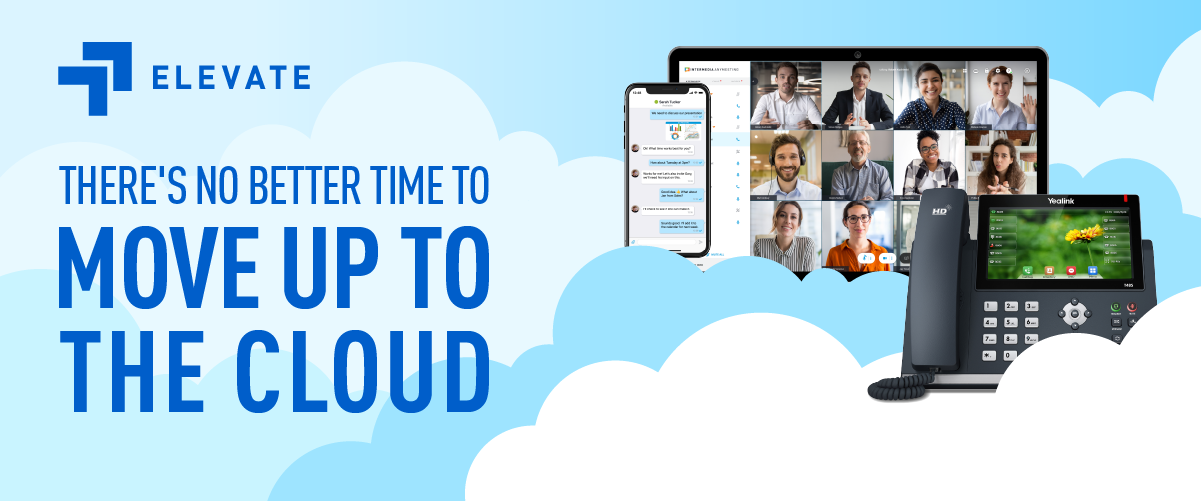Cloud Migration: The Ultimate Guide For Your Business

Every organization seems to be looking to cloud services to help scale their business in one way or another. If your business is one of those who haven’t made the transition yet, then here are a few things to consider. The most common cloud migration involves moving your email to the cloud. This allows companies to move their email systems away from an Exchange server, freeing up bandwidth and providing flexibility in allowing employees to access their email more easily from any location. Many companies are also looking into migrating their existing servers and backups from physical hardware to the cloud, which makes many essential business processes and information more accessible when and where you need it. This could also give you the ability to scale up or down at a moment’s notice.
Another business area that is seeing an increase in cloud migration is phone systems and unified communications. We’ll be diving more into that in our next post, but it’s good to keep in mind that you can migrate almost any business process to the cloud.
There are a variety of benefits to cloud services, regardless of what you’re looking to migrate:
- Scalability
- Reduced need for physical space and regular maintenance
- Greater accessibility
But there are some crucial factors that need to be considered as well when migrating to the cloud. Let’s dive a little into each of these. One of the biggest considerations for businesses who are migrating anything to the cloud is cost. The main cost difference between an on-premise backup and a cloud-based option is that on-premise backups are considered a capital expense, due to the higher up-front cost of physical hardware. Cloud-based backups don’t have that large purchase price up-front, which makes them operational expenses. This means they have a monthly fee that covers the maintenance and support needed for your backup. The benefit of a cloud-based solution is that the additional costs of housing an on-premise server (i.e. physical space to house the device, multiple power sources, and a secure and climate-controlled environment) are managed by the cloud provider and those costs are included in that monthly fee.
Cost is not the only factor to consider though. There is also the impact that cloud migration will have on your business. In an earlier post, we discussed the 3-2-1 backup rule. While there is no such thing as fail-proof technology, relying solely on either physical or cloud-based contingency plans is a recipe for disaster. Downtime is a possibility regardless of whether or not you migrate to the cloud. Even if you decide that you don’t want to risk losing access to your data by keeping it in the cloud, consider that damage to even a single electrical pole that your business relies on could mean losing power, phone connectivity, and internet service. This means your employees will lose access to any data and applications on that physical server, causing a significant impact to productivity and business continuity. But unlike housing a physical server or backup system on your own infrastructure, most cloud providers have multiple data centers and redundancy options in place so the systems that are stored in the cloud stay safe, secure and operating with limited to no downtime.
User experience is another critical factor for your business continuity. When migrating to a cloud platform you should consider how your employees will be navigating this system. The last thing you want is an overly complicated interface – especially with all the options out there for solutions. Take the time to consider what applications your employees rely on to get their job done, and then take a realistic look at what can be migrated to the cloud, and what needs to continue to live on a physical environment.
The final major consideration that businesses need to keep in mind is the actual cloud migration process itself. When migrating to the cloud, you need to make sure that the plan includes a fail-back option if your migration encounters any issues. Here are some key questions you should be asking as you map out the migration process:
- If the transition doesn’t go as planned, what is your contingency plan?
- What is your secondary contingency plan in case your first option also fails?
- If the cloud provider doesn’t live up to expectations, what options do you have?
- Do you have a full understanding of your contractual obligation with your cloud provider? Terms, conditions, service assumptions?
After you’ve spent time putting your mind to the migration, you’ll no doubt be looking to put the project in the right hands for a smooth and successful implementation. Skill set, experience, and certifications are all factors and tools needed to get the job done right. Any mechanic could replace the brakes in your car, but don’t you feel much more confident when you see that Automotive Service Excellence certification badge on their coveralls? The same applies to cloud migration – you want to have the right people in place to ensure that everything goes smoothly. Cloud migrations are typically performed by a variety of different individuals (depending on what you’re migrating to the cloud). Some of these people include
- Cloud architects
- Application specialists
- Infrastructure specialists
- Security specialists – just to name a few.
Bringing the right team to bear on your project and having an outlined and clearly defined plan in place is crucial in determining if your migration to the cloud will be successful. These are just few tips that will help keep your technology – and your business – on the right track. To learn more about how to take your business to the next level, contact the cloud migration experts at TAG Solutions today!


